This article was originally written by Bill O’Neill at UNMC
UNMC and its primary clinical partner, Nebraska Medicine, continue to expand their contribution to the state’s economic success.
According to an independent new analysis, the medical center impacts Nebraskans daily — directly or indirectly — through its statewide educational programs, bioscience research and clinical services.
The med center’s economic impact topped $5.9 billion in the last fiscal year, a 34% increase since 2018, according to the report prepared by Tripp Umbach, a national consultant with expertise in economic impact studies. The current economic impact number grows to $6.4 billion annually when considering the academic-related functions (such as residency programs and research) at UNMC affiliates, Children’s Hospital & Medical Center and the VA Health System.
UNMC, Nebraska Medicine and the affiliates also supported more than 56,000 jobs in the Nebraska economy, including not only direct employment, but also indirect jobs created through the supply chain — equipment vendors, construction workers and others.
See the report on the med center’s combined economic impact here.
“UNMC and its clinical partners continue to be an important economic engine for the state of Nebraska,” said Jeffrey P. Gold, MD, chancellor of UNMC and chairman of the board at Nebraska Medicine. “As the medical center increases its already expanding national leadership role in health professions education, research and care, our statewide economic impact will increase as well, further benefiting all of the people of Nebraska for generations to come.”
Throughout the COVID-19 pandemic, the medical center’s experts and educators provided extensive education and infectious diseases expertise to Nebraskans, efforts which stretched far beyond the economic impact, said James Linder, MD, CEO of Nebraska Medicine.
“One reason that the medical center continues to have such a beneficial economic impact on the state is its devotion to health care,” Dr. Linder said. “As medical center experts worked to keep fellow Nebraskans safe and provide reliable, timely and accurate medical knowledge to the country as a whole, the stature of our partnership and the benefits it provides continue to grow.”
Among the report’s findings:
“The state has been steadfast in its support of the mission of UNMC and its partners,” Dr. Gold said. “We see through this report that, apart from helping to meet the health care needs of our Nebraska neighbors, the state’s support advances not only the health and well-being of the citizens of our state, but it provides them a positive economic benefit as well.”
Story from the University of Nebraska at Kearney
A partnership between the University of Nebraska at Kearney and University of Nebraska Medical Center, the proposed Rural Health Education Building in Kearney will further address the need for more health care workers in the state’s rural areas.
The Rural Health Education Building would build upon an existing partnership between UNK and UNMC that’s shown great success. The two institutions opened a $19 million Health Science Education Complex on UNK’s west campus in 2015, and that facility quickly filled to capacity.
The new Rural Health Education Building would allow UNMC to expand its existing nursing programs and bring new options to the UNK campus, including occupational therapy, medical nutrition, genetic counseling and respiratory care – all high-need areas in rural Nebraska.
For the first time, the UNMC College of Medicine would educate physicians in rural Nebraska, and a Master of Health Administration would be added to complement UNK’s undergraduate program.
The Rural Health Education Building would also offer professional development, training and continuing education opportunities for existing health care workers and support research that improves the lives of Nebraskans.
May 6th through the 12th is the yearly celebration of nurses during Nurse’s Week. The past year has been an extremely trying time for nurses and frontline workers across the country but it’s a perfect time to highlight the education and preparedness the UNMC College of Nursing students receive that prepares them for moments like this. Because of these, we sought to give a few students the opportunity to speak to why this past year has solidified their reasoning to pursue this career path and the responses were nothing more than inspiring.
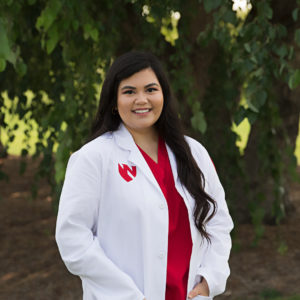
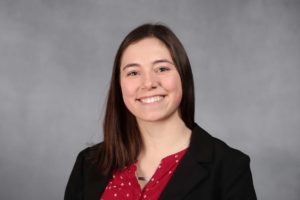
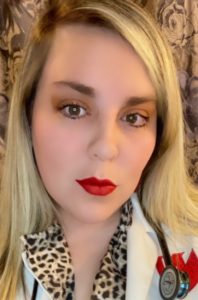
“After continuously seeing the devastation of COVID-19 this past year, my desire to become a nurse has strengthened tenfold. I studied harder than I ever had and made sure there would be nothing standing in the way of me walking the stage to get my BSN. I’d see healthcare workers on the news caring for the sick & knew that I needed to finish strong so I could get out there and help as soon as possible. I am thankful for UNMC College of Nursing – Lincoln for providing me the tools to reach this point.”
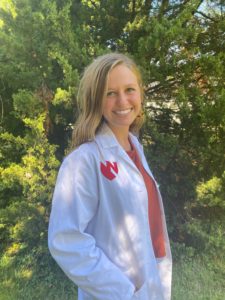
“I’ve wanted to be a nurse since I can remember. My biggest fear entering nursing school was that I would come to realize I didn’t like it or wasn’t cut out for the profession. Man could I have not been more wrong! This year has proven to me that nursing is where I belong and what I’m actually good at! I grew so much more confident in myself and my abilities through my clinical experiences and am no longer fearful, but excited to start my last year of school at UNMC.”
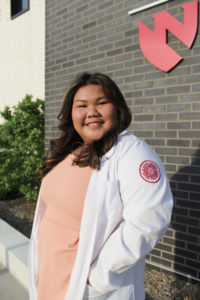
“Although everything was shutting down around me because of the COVID-19 pandemic, my passion and desire to become a nurse was only amplified. It definitely strengthened my resilience too. I had the pleasure to care for a couple of COVID patients during my critical care rotation. I have seen full recovery and families experience tremendous loss. It reminded me of how being a part of someone’s life during his or her most vulnerable time is something so special. Given the difficult circumstances with the past year, I would still choose nursing in a heartbeat.”
Children and adults with developmental and intellectual disabilities will benefit from a new facility and all new programs at the Munroe-Meyer Institute in Omaha.
Generous philanthropic support of $90 million is making it possible for the University of Nebraska Medical Center to begin redeveloping a former 220,078 square-foot office building in central Omaha into a state-of-the-art service and health care center.
The facility, located at 6902 Pine St., is adjacent to the University of Nebraska at Omaha Scott Campus and will be more than two times larger than the institute’s current facility located near South 44th and Farnam streets.
Patients, families, university representatives and others came together on Aug. 26, 2019, to celebrate the start of redevelopment. Completion of the new facility is scheduled for fall 2020, and the building will open and begin providing patient services later that year.
As Munroe-Meyer Institute begins its second century of providing services for patients with developmental and intellectual disabilities, its new home will be the first of its kind in the nation, MMI Director Karoly Mirnics, M.D., Ph.D., said. It will be uniquely designed to facilitate integrated care for the individuals and families with these disabilities and complex health care needs that MMI serves across the lifespan, he explained.
“This new facility will not only allow us to provide state-of-the-art care, but it will enable us to recruit and retain top clinicians, educators and researchers to Nebraska,” Mirnics said. “Building on 100 years of service, our vision is for a center that will provide an intimate, convenient care center for our patients while providing us with the talent and facilities to have a global impact in the areas of education and research into intellectual and developmental disabilities.”
Architects consulted with clients and clinicians to create a plan for the building that enhances and simplifies the patient experience, as well as offering an array of services not available elsewhere in the state.
Existing programs will be expanded and enhanced, while new programs and collaborations will be offered. Among the new amenities:
Several benefactors gave to the University of Nebraska Foundation to enable the university to acquire and redevelop the building in response to the exponential growth in the population that needs services.
“Once again, generous individuals and organizations have demonstrated what can be accomplished in Nebraska through giving,” said Brian Hastings, president and CEO of the University of Nebraska Foundation. “It’s because they recognize the need for this vital project that the university is able to move forward. So many people throughout Nebraska and the region will benefit from the expanded facilities, programs and specialized care that will be available at the institute.”
The University of Nebraska Foundation continues to seek contributions to support the programmatic costs associated with the institute.
Lead benefactors to the project include:
Principal benefactors to the project include:
MORE: See donor bios, renderings of the building and more
UNMC Chancellor Jeffrey P. Gold, M.D., called the new building a doorway into the institute’s second century.
“Since its beginnings, Munroe-Meyer Institute has worked to improve the lives of the people and families it serves,” Gold said. “This new home gives it a much larger space and increased versatility and flexibility, but the core of the MMI mission — helping those with intellectual and developmental disabilities to overcome challenges, to live fuller, richer lives — remains the same.
“All of UNMC is excited to see how our colleagues at MMI will continue to grow in their new home to provide even more effective clinical care, education and research, all in the name of enhancing the lives of the people and families they serve.”
Steve Sears has been highly successful in his life.
After receiving his undergraduate degree in accounting from the University of Kansas, he went to Northwestern University’s Kellogg School of Management to get his M.B.A. He was hired by PepsiCo shortly after graduating and spent two decades managing the world’s most well-known brands.
He was the chief marketing officer for Frito-Lay in Sidney, Australia, and head of marketing for the Pepsi beverage brands in New York, and he oversaw the acquisition of Stacy’s Pita Chips in Boston.
On his 50th birthday, Steve retired from his marketing career. One month later, he was diagnosed with cancer.
It was Hodgkin lymphoma, stage 4, the most advanced in the disease’s progression. Steve had experienced symptoms for months, but he hadn’t been accurately diagnosed, so the cancer had continued its steady march, coursing through his blood and, ultimately, his organs.
At the time, Steve and his husband were in the process of moving from Boston to Kansas City, where Steve had grown up and his parents still lived. But they decided to stay and seek treatment at Beth Israel Deaconess Medical Center, the teaching hospital of Harvard Medical School, where Steve’s doctor was affiliated. Six months of grueling chemotherapy, and Steve was in full remission.
The move to Kansas City went forward, and Steve’s post-treatment care was set up with the University of Kansas Cancer Center. But at his six-month checkup, Steve was told the cancer was back. It was devastating news.
When cancer, specifically lymphoma or leukemia, returns so quickly, a stem cell transplant is often the best course, and that’s what Steve’s doctor recommended.
Steve quickly educated himself on the procedure and prepared for it. But a week before the transplant, Steve received a call from the cancer center’s finance department. His insurance was not affiliated with KU, and his treatment could not be authorized. It was a sinking feeling, but Steve was told a highly rated facility could take him: the University of Nebraska Medical Center.
The following day, Steve received a call from UNMC saying Julie Vose, M.D., the chief of the division of oncology/ hematology and an internationally known expert on lymphoma, could see him the next day. He drove to Omaha, and from the moment he stepped through the doors and into the waiting room, he felt the warmth of the people who would be his caregivers and life-savers over the next several weeks.
Steve spent five weeks in Omaha, and today, he is six years in remission. When he looks back at the experience, he believes it turned out for the best. Even the fact that the hospital was three hours from home turned out to be a blessing. “My husband and I just kind of sequestered ourselves in Omaha,” he said.
Most importantly, Steve received first-class care, a successful treatment — and kindness.
“You’re so stressed out when you have a life-threatening diagnosis,” he said, “and it’s just so comforting to turn your life over to people who not only do you trust for their technical skills but also who have empathy and just general kindness and humor.”
There were, of course, low points and stressful times during his treatment. But that’s not what Steve remembers. He remembers the people he met, a few in particular: Dr. Vose, his primary physician, Stacy Rooker, his case manager, and a nurse practitioner named Mark Brown.
Mark and Steve had only one interaction, but it came on a difficult day. Steve was feeling frustrated and downhearted, and Mark lifted his spirits. “He spent probably 10 minutes with me,” Steve said, but after Mark walked out, “I felt like a new person, and I never forgot that. It was like he was my angel that day.”
On the fifth anniversary of his transplant, Steve worked with the University of Nebraska Foundation to throw a surprise reception for the three people who had most impacted him during his treatment. He also announced a generous estate gift to support cancer research at UNMC.
UNMC is not the only beneficiary of Steve’s generosity. When planning his estate, he thought about everyone who helped him succeed in his career and find happiness in his personal life.
“It’s been one of my life’s great joys to get that plan together and then have the fun of going around and telling the organizations in the plan that they’re going to receive a gift someday — hopefully many, many years from now — and see the excitement and appreciation that they have.”
Steve has been highly successful in his life. And that has enabled him to give back to the causes that matter to him. But the people who enabled his success saved his life and showed him compassion — those are the ones who inspired him to do so.
PHOTO: Members of the UNMC research team included: Back row (left-right) – James Hilaire, Brady Sillman, Ph.D., Larisa Poluektova, M.D., Ph.D., Santhi Gorantla, Ph.D., Benson Edagwa, Ph.D., and Hang Su; Front row — R. Lee Mosley, Ph.D., JoEllyn McMillan, Ph.D., Howard Gendelman, M.D., Prasanta Dash, Ph.D., Saumi Mathews, Ph.D., Mary Banoub, and Zhiyi Lin. Missing from photo – Aditya Bade, Ph.D. and Nagsen Gautam, Ph.D.
In a major collaborative effort, researchers at the University of Nebraska Medical Center (UNMC) and Temple University Lewis Katz School of Medicine have for the first time eliminated replication-competent HIV-1 DNA — the virus responsible for AIDS — from the genomes of living animals.
The study, reported today in Omaha and in the journal Nature Communications, marks a critical step toward the development of a possible cure for human HIV infection.
“This achievement could not have been possible without an extraordinary team effort that included virologists, immunologists, molecular biologists, pharmacologists, and pharmaceutical experts,” said Howard Gendelman, M.D., Margaret R. Larson Professor of Infectious Diseases and Internal Medicine, chair of the Department of Pharmacology and Experimental Neuroscience and director of the Center for Neurodegenerative Diseases at UNMC. “Only by pooling our resources together were we able to make this groundbreaking discovery.”
“Our study shows that treatment to suppress HIV replication and gene editing therapy, when given sequentially, can eliminate HIV from cells and organs of infected animals,” said Kamel Khalili, Ph.D., Laura H. Carnell Professor and chair of the Department of Neuroscience, director of the Center for Neurovirology, and director of the Comprehensive NeuroAIDS Center at LKSOM.
Drs. Gendelman and Khalili were senior investigators on the new study.
Current HIV treatment centers on the use of antiretroviral therapy (ART). ART suppresses HIV replication but does not eliminate the virus from the body. Therefore, ART is not a cure for HIV, and it requires lifelong use. If it is stopped, HIV rebounds, renewing replication and fueling the development of AIDS. HIV rebound is directly attributed to the ability of the virus to integrate its DNA sequence into the genomes of cells in the immune system, where it lies dormant and beyond the reach of antiretroviral drugs.
In previous work, Dr. Gendelman’s team used a therapeutic strategy known as long-acting slow-effective release (LASER) ART co-developed by Benson Edagwa, Ph.D., assistant professor of pharmacology at UNMC.
Dr. Khalili’s team used CRISPR-Cas9 technology to develop a novel gene editing and gene therapy delivery system aimed at removing HIV DNA from genomes harboring the virus. In rats and mice, they showed that the gene editing system could effectively excise large fragments of HIV DNA from infected cells, significantly impacting viral gene expression. Similar to ART, however, gene editing cannot completely eliminate HIV on its own.
For the present study, Dr. Gendelman and his team led by Prasanta Dash, Ph.D., instructor of pharmacology, combined its LASER ART strategy with the gene editing system.
LASER ART targets viral sanctuaries and maintains HIV replication at low levels for extended periods of time, reducing the frequency of ART administration. The long-lasting medications were made possible by pharmacological changes in the chemical structure of the antiretroviral drugs. The modified drug was packaged into nanocrystals, which readily distribute to tissues where HIV is likely to be lying dormant. From there, the nanocrystals, stored within cells for weeks, slowly release the drug.
Dr. Khalili said, “We wanted to see whether LASER ART could suppress HIV replication long enough for CRISPR-Cas9 to completely rid cells of viral DNA.”
To test their idea, the researchers used mice engineered to produce human T cells susceptible to HIV infection, permitting long-term viral infection and ART-induced latency. Once infection was established, mice were treated with LASER ART and subsequently with CRISPR-Cas9. At the end of the treatment period, mice were examined for viral load. Analyses revealed complete elimination of HIV DNA in about one-third of HIV-infected mice.
“The big message of this work is that it takes both CRISPR-Cas9 and virus suppression through a method such as LASER ART, administered together, to produce a cure for HIV infection,” Drs. Gendelman and Khalili said in a shared statement. “We now have a clear path to move ahead to trials in non-human primates and possibly clinical trials in human patients within the year.”
“The ability to excise HIV-1 DNA from the genomes of infected animals depends on LASER ART’s abilities to maximally restrict ongoing infection. This concept of combining both modalities provides a pathway forward to future studies in humans,” Dr. Gendelman said.
How you may help
While research breakthroughs such as this rely on critical grant funding, private contributions of every amount also make these scientific discoveries possible. Gifts help provide research equipment and instruments, endowed support for faculty, support for fellowships for graduate researchers, program support and much more.
If you are interested in supporting the lifesaving HIV research underway at the University of Nebraska Medical Center, please consider a contribution to the Community Pride and Distinguished Science Research Fund (01087930). Your gift will enable the Department of Pharmacology and Experimental Neuroscience to continue this important work.
You may give online now or send a check made payable to the University of Nebraska Foundation to: University of Nebraska Foundation, PO Box 82555, Lincoln NE 68501-2555. Please include in the memo line of your check the fund number 01087930.